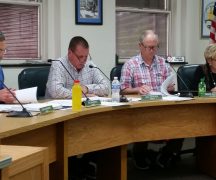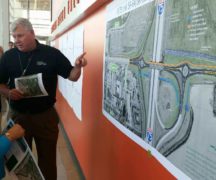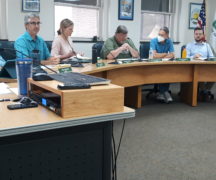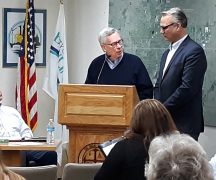By JAN LARSON McLAUGHLIN
BG Independent News
A citywide rental registry and historic preservation scored at the top as Bowling Green City Council members ranked their priorities in the new Community Action Plan.
All council members were asked to choose their priorities from the expansive CAP. Five out of the seven council members put a registry of rental properties and historic preservation of neighborhoods on their lists.
Also making the priority list were zoning updates, micro-grants for neighborhoods, bicycle lanes and Carter Park updates.
“This is exactly what I was hoping for,” council president Mike Aspacher said Monday to council member Greg Robinette, who compiled the list of priorities based on council’s input. “This is a bold step.”
The CAP gave the city a lot to digest, so council agreed to set some initial priorities.
“We’re hoping our citizens will stick with us,” Aspacher said.
Robinette did not assign deadlines, and suggested that projects will move ahead when funding is available.
“It’s going to be determined by resources,” he said.
Council member Bruce Jeffers approved of the plan to address priorities first.
“I’m glad we’re pursuing this route,” he said.
Robinette reported to council the results of their prioritizing, and instructed city administration of the next steps to achieve those goals.
Following is a list of the priorities:
RENTAL REGISTRATION
The city administration was asked to draft a preliminary inspection program for a city-wide rental property registration program, which includes a landlord self-certification process to improve rental property conditions.
According to Robinette, this type of program can result in improved rental conditions without potentially intrusive home inspections by city code enforcement.
The city would develop a checklist of common violations, give the landlords discretion as to whether these violations exist on the property, and provide information to renters to help them evaluate their current or potential rental units.
Robinette asked the city administration to identify the resources currently available, the resources needed for the program, and cost estimates for implementation.
The estimated cost for this program is $10,000 to $50,000.
HISTORIC PRESERVATION
The city administration and mayor were asked to review the creation of a Historic Preservation Ordinance and Commission. Under this goal, the city would create a historic building inventory of single-family reinvestment areas, and establish one or more local historic districts deemed significant to the city’s cultural fabric.
Historic districts can protect investments of owners and residents, increase rate of appreciation, encourage better quality design, improve sustainability, serve as a vehicle for education, increase tourism, enhance business recruitment potential, and give communities a voice in their future.
CORE ZONING DISTRICT
The city administration, planning director and planning commission were instructed to work to establish a new core zoning district for the area on East Wooster Street between downtown and the BGSU campus. The new zoning district could allow for buildings with minor additional height increases to promote use intensity and encourage a population level attractive to commercial development.
It is suggested that properties be rezoned at Thurstin/Manville and Wooster streets, to promote redevelopment of these sites.
The estimated cost for this is “low.”
CITY-WIDE ZONING UPDATE
The administrator and planners were asked to study the zoning code for consistency of language for variances and conditional use requests.
A variance is a tool to permit a property owner to make an improvement or operate a business in a manner different than normally allowed under the ordinance. The CAP suggests more rigorous criteria to be met before the city will approve a variance.
The estimated cost for this is between $50,000 and $100,000.
MICRO-GRANT PROGRAM
The city administrator and departments were asked to help implement a micro-grant program for the Target Reinvestment Areas, which are primarily residential sections of the northeast and southeast neighborhoods that are showing signs of lack of investment and increasing blight. The grants would be less than $5,000 per grant.
The funds distributed through this program can provide Bowling Green organizations and neighborhood groups with empowerment and financial support for activities that promote citizen engagement, enhance neighborhood beautification, improve safety, encourage economic development, and address neighborhood needs.
The cost of this would be between $10,000 and $50,000.
BICYCLE LANES
Information should be forwarded to the Bicycle Commission about a grant application for new on-street bicycle lanes along Court Street. Feedback from last year’s Court Street Connects event showed strong support for the bike lanes.
The cost was listed as “low.”
OTHER NEW BICYCLE INFRASTRUCTURE
City Council would like a plan for new bicycle infrastructure on Clough Street, Scott Hamilton Avenue, Thurstin Avenue and College Drive corridors. This would provide bicyclists with their own designated space on the road, for safety concerns.
Providing the infrastructure to reduce the risk of accidents and dispel perceptions of danger is a preliminary step to encouraging students to commute by bicycle.
The cost is estimated at $100,000 to $1 million.
TAX INCREMENT FINANCING
The administration was asked to provide City Council with an explanation of the Tax Increment Financing program, in case council wants to use the TIF to fund public infrastructure improvements in the Core Development Area, along East Wooster Street between the downtown and campus.
TIF is an economic development tool available to local governments in Ohio to finance public infrastructure and in some cases, residential rehabilitation.
The estimated cost is between $10,000 and $50,000.
CARTER PARK REDESIGN AND UPDATES
The administrator and parks & recreation director were asked to work with park board to draft recommendations to improve Carter Park. The goal is to make the park more usable for surrounding residents and draw visitors from other areas.
Updates under consideration include reconfigured athletic fields, natural spaces and trails, features designed for kids and seniors, and community gathering spaces for picnics and events.
The cost is estimated at $100,000 to $1 million.
WORK WITH BGSU ON PUBLIC-PRIVATE PARTNERSHIP
The administration was asked to study the public-private partnership with BGSU. One goal is to develop vacant university-owned property west of the CSX tracks between Evers Avenue and Ridge Street, as well as the existing parking lots between Ridge and Court streets. That is estimated at more than $1 million.
The other goal is to work with BGSU to develop vacant university-owned property with mixed-use development including townhouses between Williams Street and Baldwin Avenue, as well as the corners of East Wooster at State Street and University Lane. This also is estimated at more than $1 million.





